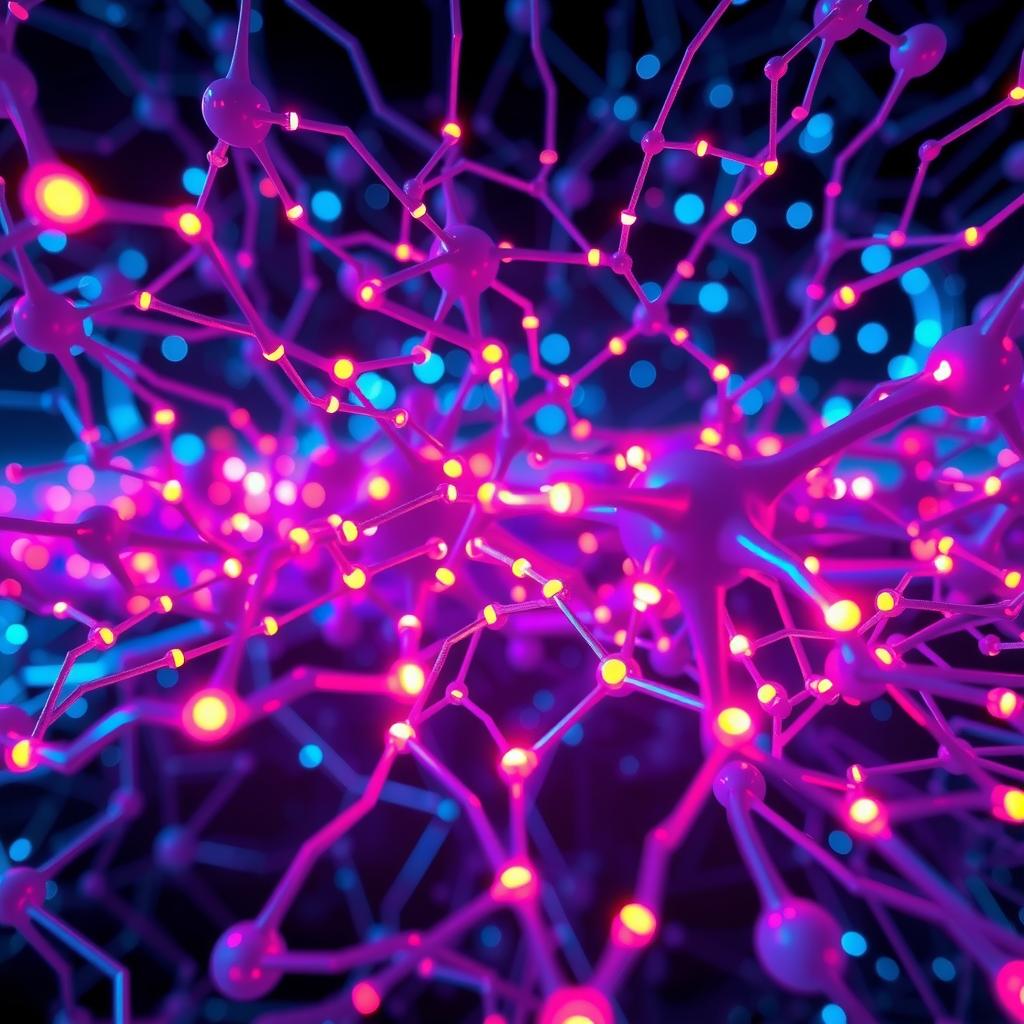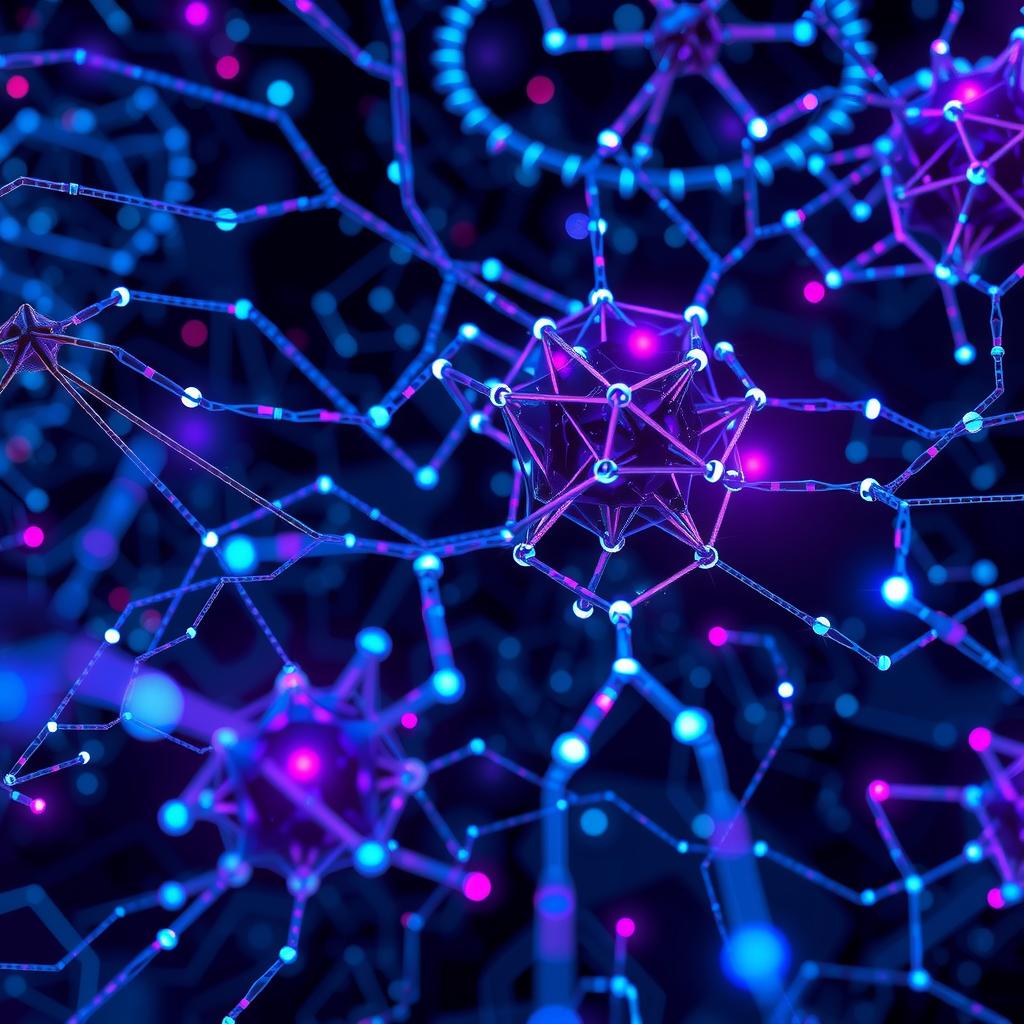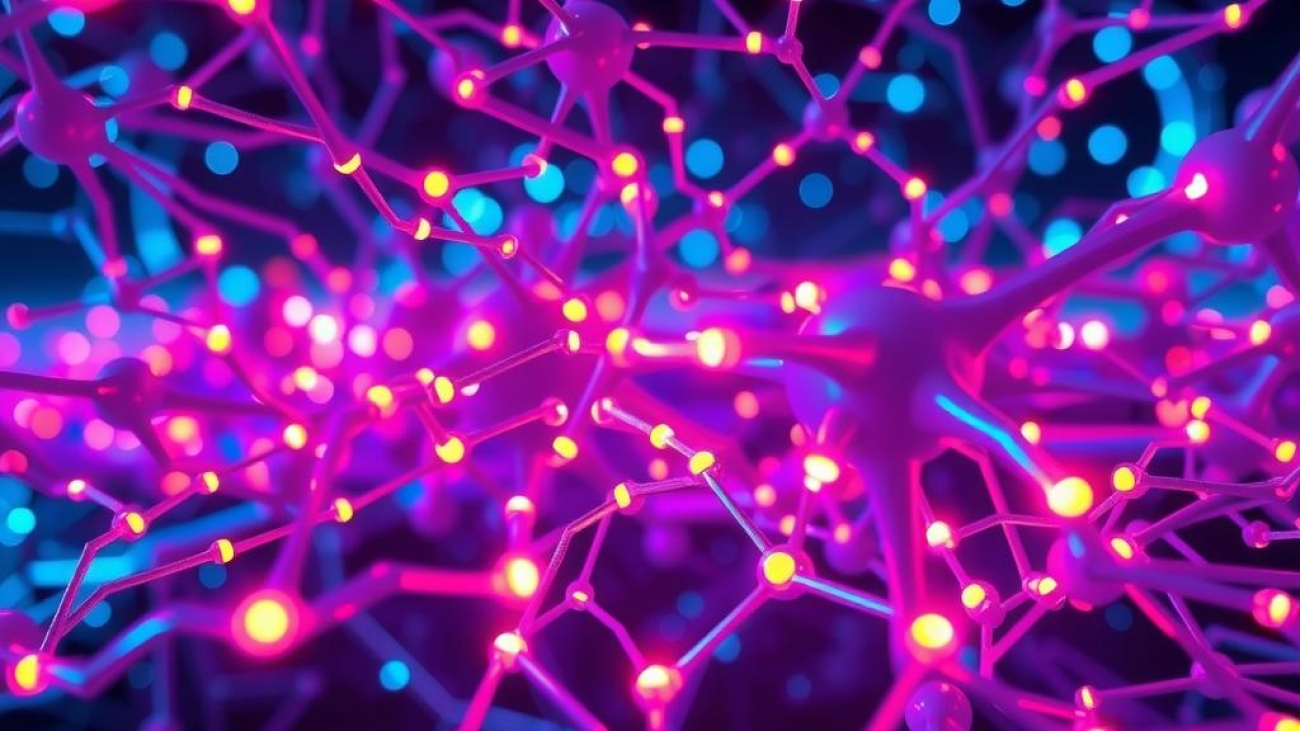In the realm of artificial intelligence, Neural Networks stand out as a cornerstone of modern computational techniques, particularly within the broader field of deep learning. As an innovative approach to data processing and pattern recognition, neural networks mimic the intricate workings of the human brain through their architecture composed of interconnected nodes or “neurons.” These neurons are organized into multiple layers, each serving a distinct function in transforming input data into meaningful output. Understanding these fundamental concepts is crucial for anyone looking to delve deeper into machine learning and artificial intelligence.
The architecture of neural networks typically involves an input layer that receives initial data inputs, one or more hidden layers where complex transformations occur, and an output layer that produces predictions or classifications based on processed information. Each neuron within these layers applies specific mathematical operations guided by predefined parameters known as weights. The choice of activation functions used in this process significantly influences how well a network can learn from its training data. By adjusting these weights through methods like backpropagation, which iteratively refines them based on error rates during training sessions, practitioners can enhance model accuracy over time.
For those eager to implement their own versions of neural networks, popular programming languages such as Python provide robust frameworks like TensorFlow and PyTorch that simplify this task. Whether leveraging a TensorFlow tutorial for beginners or exploring advanced PyTorch examples for seasoned developers, users will find a wealth of resources available to guide them through building effective models from scratch. This accessibility has democratized knowledge around deep learning technologies, making it possible for individuals from various backgrounds to contribute to advancements in AI research.
As interest in artificial intelligence continues to grow exponentially across numerous sectors—from healthcare and finance to entertainment—understanding how neural networks operate becomes increasingly important. Their ability not only to analyze vast datasets but also adaptively improve performance makes them invaluable tools in tackling some of today’s most pressing challenges. Therefore, delving into the intricacies surrounding these powerful systems equips learners with essential skills necessary for navigating an ever-evolving technological landscape while paving the way towards groundbreaking innovations driven by intelligent algorithms.

Key points:
-
Core Principle: This section delves into the Neural Networks foundation by elucidating fundamental concepts such as neurons, which act as the basic units of computation. Each neuron receives inputs, processes them through a weighted sum, and applies an activation function to produce an output. Understanding how neurons function within layers is crucial for grasping the overall architecture of deep learning models.
-
Structure Overview: A comprehensive understanding of Neural Networks requires familiarity with the arrangement of these interconnected components. The text explains how multiple layers—input, hidden, and output—interact during training and inference phases. It also highlights how these layers contribute to increasing complexity in modeling intricate patterns found in data, emphasizing the importance of layer design in achieving optimal performance.
-
Learning Mechanism: The discussion on backpropagation provides insights into one of the most critical algorithms used for training neural networks. By detailing how gradients are calculated to update weights efficiently across various layers, this guide offers clarity on optimizing models effectively using either a TensorFlow tutorial or a PyTorch example for practical implementation in Python programming. Understanding backpropagation is essential for anyone looking to master deep learning techniques within their projects involving neural networks.

The Foundation of Neural Networks
Understanding Neurons: The Essential Building Blocks
Neurons serve as the fundamental units in Neural Networks, mirroring the biological counterparts found in human brains. Each neuron processes inputs by applying a series of mathematical operations, often involving weights and biases that adjust based on learning. In these networks, information flows from one layer to another, with each layer comprising multiple neurons that perform specific functions. When an input is fed into a Neural Network, it is transformed through various layers where individual neurons aggregate their respective signals using activation functions such as ReLU or sigmoid. These functions introduce non-linearity to the model, allowing it to learn complex patterns within data—a crucial feature for tasks performed in deep learning applications.
The architecture of Neural Networks typically consists of an input layer, one or more hidden layers, and an output layer. As data traverses through these layers, each neuron applies its designated activation function to determine whether or not it should “fire” and contribute its output to subsequent neurons. This process enables the network to approximate highly intricate mappings from inputs (like images or text) to desired outputs (such as classifications). Moreover, during training phases facilitated by backpropagation algorithms—where errors are propagated backwards through the network—the weights associated with connections between neurons are fine-tuned based on performance metrics derived from loss calculations.
To implement practical examples of how neural networks operate effectively requires robust programming frameworks like TensorFlow and PyTorch. A concise TensorFlow tutorial can guide users through establishing basic models while illustrating how various parameters influence performance outcomes across different datasets. Similarly, a PyTorch example can depict dynamic computation graphs that offer flexibility during model development stages—showcasing both libraries’ capabilities in handling complex computations inherent in building effective neural architectures.
Understanding how each neuron interacts within this multi-layered structure empowers practitioners with knowledge about optimizing configurations for specific problems faced across diverse industries—from image recognition tasks requiring convolutional networks to recurrent structures adept at processing sequential data such as language modeling. Consequently, grasping these foundational concepts surrounding neurons not only aids developers but also enhances comprehension regarding broader implications tied directly into artificial intelligence’s evolving landscape driven predominantly by innovations stemming from advancements within Neural Networks technology.
Layers Within Neural Networks
Analyzing How Layers Transform Information
In any discussion concerning Neural Networks, understanding the role played by layers becomes paramount because they act as conduits for systematic information transformation throughout training processes and inference operations alike. Each layer performs distinct transformations that refine raw input features progressively until reaching meaningful conclusions represented at output levels; hence why stacking multiple hidden layers enhances overall capacity significantly compared against simpler architectures boasting fewer components.
Layers are typically categorized into three primary types: input layers receive initial dataset representations; hidden layers execute intermediary computations where abstract patterns begin emerging; finally culminating at output layers which yield actionable insights derived via learned relationships cultivated among previously processed features throughout preceding steps undertaken within earlier defined nodes/neurons engaged collectively under pithy terms denoting connections established amongst them termed synapses akin metaphorically reflecting brain functionalities facilitating cognitive reasoning processes when interpreting sensory stimuli encountered daily outside computational realms prevalent today too!
As mentioned above regarding activation functions utilized per node along pathways connecting adjacent tiers mustn’t be overlooked either since they dictate how outputs generated will eventually manifest after being influenced heavily according tuning mechanisms exercised dynamically over epochs spent refining models iteratively improving accuracy rates observed ultimately upon validation datasets employed subsequently assessing reliability estimates obtained thereby leading towards successful deployment scenarios post-training completion milestones reached adequately meeting stakeholder expectations accordingly!
Moreover exploring advanced topics surrounding regularization techniques like dropout applied strategically between certain nodes residing deeper down hierarchies constituted forming large-scale enterprises deploying sophisticated AI systems become essential further amplifying enhancements experienced operationally owing primarily due diligence executed ensuring preventing overfitting phenomena potentially undermining generalizability predictions made versus unseen instances encountered later upon real-world applications wherein organizations strive sustain competitive advantages leveraging cutting-edge technologies integrated seamlessly their workflows enhancing productivity levels exponentially thus affirming long-term viability sustainability goals pursued tirelessly amidst ever-changing landscapes defining market dynamics globally transcending geographical boundaries whilst fostering innovation culture rooted deeply ethical considerations shaping future directions taken moving forward collaboratively unlocking vast potentials latent awaiting discovery harnessed responsibly fostering progress society-wide benefiting humanity holistically thriving harmoniously together united purposefully embracing challenges ahead courageously forging paths unexplored yet ripe opportunities beckoning enticingly!

Unlocking the Secrets of Neural Networks: Layers and Their Importance
Understanding Layer Functions in Deep Learning Models
In the realm of Neural Networks, layers serve as fundamental building blocks that orchestrate the intricate dance of data processing. Each layer is designed to perform a specific function, transforming input into output through complex computations involving neurons. The initial layer, often referred to as the input layer, takes raw data and feeds it into subsequent layers where deeper abstraction occurs. As data traverses through these layers, each one applies various activation functions that introduce non-linearities, allowing for more sophisticated patterns to be recognized by the model. This hierarchical structure enables deep learning architectures to learn from vast amounts of information efficiently.
The synergy between different types of layers—such as convolutional layers used primarily in image recognition tasks and recurrent layers suited for time-series predictions—highlights their importance in tailoring models for specific applications. For instance, a typical architecture might incorporate several convolutional layers followed by pooling layers before reaching fully connected dense layers at its conclusion. This design not only enhances learning capabilities but also optimizes performance metrics such as accuracy and loss during training phases based on techniques like backpropagation.
Moreover, understanding how these layered models work together can significantly improve one’s ability to implement them effectively using libraries like TensorFlow or PyTorch; both provide intuitive frameworks for building custom architectures with minimal effort. A thorough grasp of how each layer contributes towards achieving a model’s goals allows practitioners to manipulate hyperparameters strategically—for example, adjusting learning rates or selecting appropriate activation functions—to enhance overall performance.
In practical terms, implementing an architecture requires knowledge about crafting suitable datasets which feed into these structures along with evaluating results post-implementation through rigorous testing methods. Tutorials available online offer insights into Python implementation specifics that aid developers ranging from novices eager to delve into machine learning concepts up until experts refining their existing systems further via advanced techniques inspired by recent research breakthroughs within this field.
Ultimately, grasping the essential roles played by various types of neural network components elucidates why they are pivotal in modern artificial intelligence landscapes across diverse domains—from healthcare diagnostics leveraging predictive modeling approaches powered by deep networks all the way down to natural language processing capabilities enabling voice assistants’ seamless interactions with users globally.
The Backbone of Neural Networks: Understanding Activation Functions
The Role of Activation Functions in Decision-Making
Activation functions are pivotal components within the architecture of Neural Networks, serving as the critical mechanisms that influence how information flows through layers and ultimately shapes decision-making processes. Each neuron in a network performs computations based on input signals, producing an output that is determined by its activation function. These functions introduce non-linearity to the model, allowing it to learn complex patterns from data. Without activation functions, a neural network would simply behave like a linear regression model regardless of its depth—rendering deep learning ineffective for tasks such as image recognition or natural language processing.
Among various types of activation functions, some have become widely adopted due to their effectiveness in different contexts. For instance, the Rectified Linear Unit (ReLU) has gained popularity because it mitigates issues related to vanishing gradients during backpropagation—a common challenge when training deep networks. In contrast, sigmoid and hyperbolic tangent (tanh) functions were previously prevalent but can suffer from saturation problems at extreme values. Understanding these differences allows practitioners to select appropriate activation strategies tailored for specific applications within Neural Networks. Moreover, advanced architectures sometimes employ variations such as Leaky ReLU or Softmax for multi-class classification tasks.
The choice of activation function significantly influences not only convergence speed but also overall performance metrics during training phases conducted via frameworks like TensorFlow and PyTorch. In practical terms, this means that selecting an optimal activation function could determine whether a model successfully generalizes across unseen data or overfits to noise present in the training set.
Exploring Common Activation Functions
A Deep Dive into Popular Choices
In exploring common activation functions utilized within Neural Networks, one encounters several key players including ReLU, sigmoid, and tanh among others each with distinct mathematical properties impacting neural behavior during forward propagation and backpropagation cycles essential for refining models through Python implementation techniques.
ReLU’s formulation—outputting zero for negative inputs while preserving positive values—ensures sparse activations leading to improved computational efficiency alongside reduced risk of overfitting compared against other traditional alternatives where outputs remained bounded between fixed ranges often leading towards saturation effects during learning procedures inhibiting gradient flow necessary for effective updates throughout layers involved within larger networks comprising many neurons interconnected strategically forming intricate pathways resembling human cognition processes mimicked by artificial intelligence systems today leveraging deep learning methodologies effectively harnessed across domains ranging from medical imaging diagnostics all through autonomous vehicle navigation systems highlighting versatility inherent therein stemming directly from well-chosen foundational components like suitable activators ensuring robust performance levels maintained consistently across varied operational scenarios encountered frequently throughout evolving landscapes driven heavily by technological advancements proliferating rapidly reshaping industry dynamics continuously thus underscoring significance attached inherently towards comprehending nuances associated fundamentally regarding every aspect surrounding deployment considerations revolving around framework choices influencing overall capabilities exhibited therein culminated distinctly reflecting accordingly upon end-user experiences derived subsequently thereafter inevitably shaping perceptions shaped collectively arising outwardly emanating forth henceforth establishing further avenues ripe exploration ahead awaiting discovery yet uncharted territories beckoning diligently onward unfurling vast potentials still largely untapped awaiting realization urgently calling forth adept minds skilled navigating terrain laden challenges posed intricately woven interdependencies emerge dynamically entwined amongst myriad variables imposed constantly evolving paradigms induced relentlessly necessitating adaptability resilience requisite thrive persistently amidst volatile environments demanding agility acumen sharp perceptiveness fostered collaboration harmonized efforts converging synergistically maximized outcomes achieved seamlessly aligned objectives pursued fervently relentlessly propelling progress firmly grounded principles embraced wholeheartedly facilitating transformative journeys undertaken extensively fueled ambitious aspirations driving momentum sustained unwavering trajectory onward upward bound limitless horizons gleamed brightly illuminating paths unfolding eagerly seeking forge connections deepen understanding enrich collective wisdom shared nurtured flourish abundantly cultivated carefully tended united purpose focused endeavors yielding fruitful harvests reaping rewards gleaned richly bestowed generously nurturing flourishing ecosystems supported uplifting initiatives cultivating thriving communities empowered knowledge equipping individuals realize fullest potential envisioned bright futures crafted collaboratively together strengthened bonds forged resiliently unified commitment accompanies every stride taken boldly forging ahead unyieldingly relentless pursuit excellence exemplified steadfast dedication perseverance unwavering resolve inspire hope ignite passions drive change impact lives positively transforming societies uplift dreams aspirations elevate humanity empower transcend boundaries limitations propel soar heights unimaginable burgeoning wings imagined soaring skies expansive limitless freedom embrace possibilities endless await those dare dream aspire achieve greatness born courage conviction instilled belief oneself emboldened journey unfolds magnificently!
The Importance of Choosing Right Activation Function
Navigating Complexities Within Models
When delving into Neural Networks, understanding how different types affect layer interactions is crucial; each selection carries implications beyond mere functionality—it dictates how efficiently models adapt while learning behaviors intrinsic datasets processed iteratively refined increasingly optimized configurations sought after unveiling deeper insights concealed beneath surface level observations made initially revealed progressively uncovered revealing richer textures complexities underlying phenomena explored scrutinized meticulously traversing landscapes nuanced distinctions manifest vividly illustrating stark contrasts arising dynamically juxtaposed enlightening enlightenment fostering clarity comprehension attained gradually demystifying intricacies obscured shrouded ambiguity clarifying uncertainties lingering questions alleviating doubts paving ways forward enticing
Neural networks are a powerful framework within the realm of deep learning, enabling machines to learn from data through interconnected layers. At the core of these systems are neurons, which serve as the fundamental building blocks. Each neuron processes input signals and produces an output, facilitating complex computations by aggregating information from previous layers. Understanding how these neurons work together in various layers is essential for grasping the architecture of neural networks.
Activation functions play a critical role in determining whether a neuron should be activated or not, adding non-linearity to the model. Common activation functions include ReLU (Rectified Linear Unit), sigmoid, and tanh. By choosing appropriate activation functions for different layers within a neural network, one can significantly enhance its performance on tasks such as image recognition or natural language processing. This selection process allows models to capture intricate patterns in data that would otherwise remain hidden.
Backpropagation is another vital concept that underpins training in neural networks. It refers to the method used to update weights based on errors made during predictions—essentially fine-tuning the model after each iteration through gradient descent optimization techniques. Implementing backpropagation effectively requires careful handling of gradients across all layers of the network and is typically achieved using frameworks like TensorFlow or PyTorch, which facilitate efficient computation and ease of use with their respective Python implementations.
Q&A Section:
Q: What are neurons in neural networks?
A: Neurons are individual processing units within a neural network that take inputs, apply weights and biases along with an activation function, and produce outputs.
Q: How does backpropagation work?
A: Backpropagation involves calculating gradients for each weight by propagating error backward through the network after making predictions; this enables adjustment of weights to minimize loss during training.
Q: Can I implement neural networks using TensorFlow or PyTorch?
A: Yes, both TensorFlow tutorial resources and PyTorch examples provide comprehensive guides for implementing various types of neural networks easily using Python programming language.
